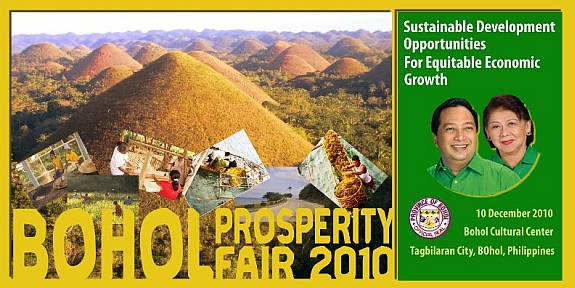Even as the provincial government and the city and municipal LGUs are gearing up for the Bohol Development Initiatives for Prosperity Fair 2010, set this December 10 at the Bohol Cultural Center, an expanded “market” for the Fair now includes an unprecedented range of development stakeholders, institutions, and organizations.
With the theme Sustainable Development Opportunities for Equitable Economic Growth, the Prosperity Fair is an expansion of the Bohol Poverty Fair, which had been successfully conducted before by the province in 2006, 2007, and 2008.
Explaining the enhanced concept and the renaming of the activity, Governor Edgar Chatto noted that, although Bohol has met with considerable success in reducing poverty incidence, poverty cannot be fully addressed without achieving economic growth for every Boholano household. The governor added that the change is also in line with the thrust for public-private partnership advocated by the national government.
“We are therefore vigorously pursuing this new focus of local economic development,” he stressed.
In addition to the Official Development Assistance (ODA) agencies that have already partnered and continue to implement development projects with the province, such as the Australian Agency for International Development (AusAID), Japanese International Cooperation Agency (JICA), Korean International Cooperation Agency (KOICA), Canadian International Development Agency (CIDA), and many others, the provincial government has, this year, extended its invitation to National Government Agencies (NGAs), Government-Owned and/or Controlled Corporations (GOCCs), major corporations and businesspeople, Non-Government Organizations (NGOs), Civil Society Organizations (CSOs), LGUs, and other development stakeholders.
The provincial government has also invited over LGUs and other organizations interested in partnering with Bohol or in replicating the Fair in their respective localities.
During the affair, the provincial government and the individual municipal/city LGUs in Bohol, grouped into five different Bohol Integrated Area Development (BIAD) clusters, will occupy booths at which they will present their project proposals, for the perusal and review by representatives of ODA agencies and other interested funding agencies and for discussion on possible assistance, partnering, or other modes of collaboration.
The governor clarified that, where appropriate, the city/municipal LGUs are willing to provide counterpart funding for their own project proposals as well as those that may be presented by their respective BIAD cluster.
The Fair is an initiative of the provincial government in its continued efforts towards poverty reduction in parallel with local economic development in support of the national government’s development thrusts and the Millennium Development Goals.
The governor expressed his hopes for sustained partnerships with the province’s development stakeholders and, addressing concerns on sustainability of programs and continuity of local government support, gave the assurance that even with the recent change of administration, the province is still serious in its intent to redouble its efforts and contribution to all ongoing programs and projects.
“Our interest is not just in seeing these programs succeed in the short-term, but in seeing them create positive impact for Boholanos over the long term,” Chatto confided.
The expanded scope of the Fair is seen to reflect the province’s new Executive-Legislative Development Agenda and its Overarching Development Framework, which the administration of Gov. Chatto and Vice Governor Concepcion Lim have condensed in the acronyms HEAT Bohol and LIFE HELPS.
HEAT Bohol stands for Health and Sanitation, Education and Technology, Agriculture and Food Security, and Tourism and Livelihood, while LIFE HELPS sums up the strategies for: Livelihood and Tourism, Infrastructure, Food Security, Education, Health, Environment, Leadership Development, Peace and Order, and Sports and Youth Development. (pjjv/G.O. EDCom)

